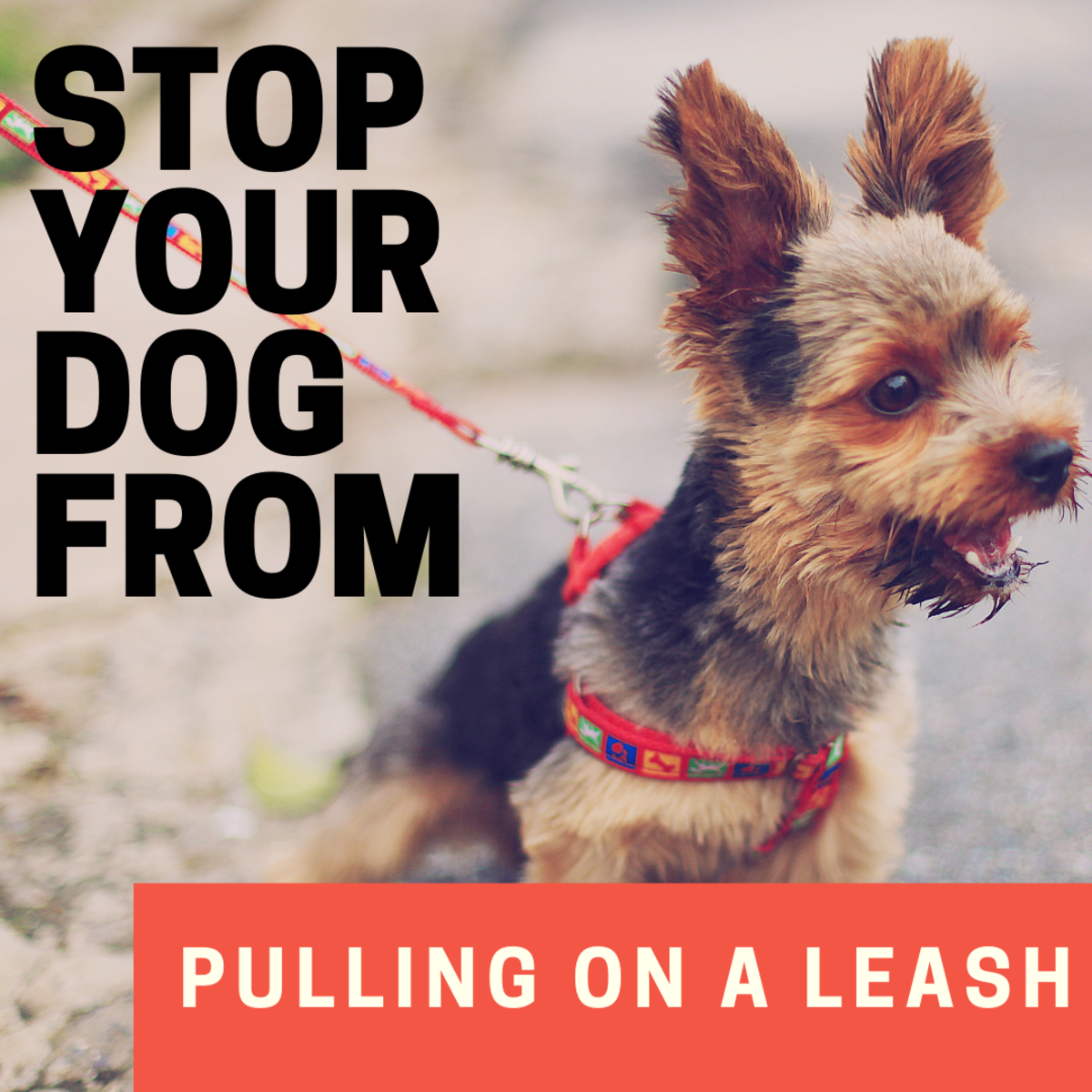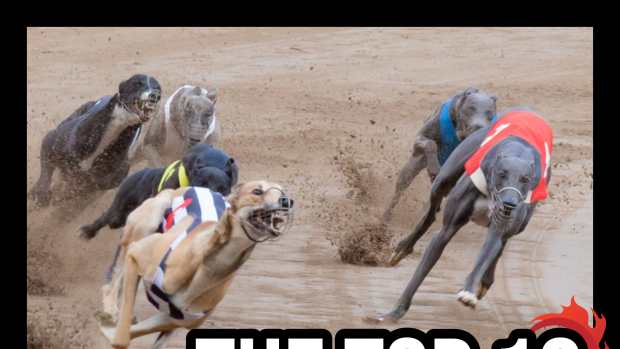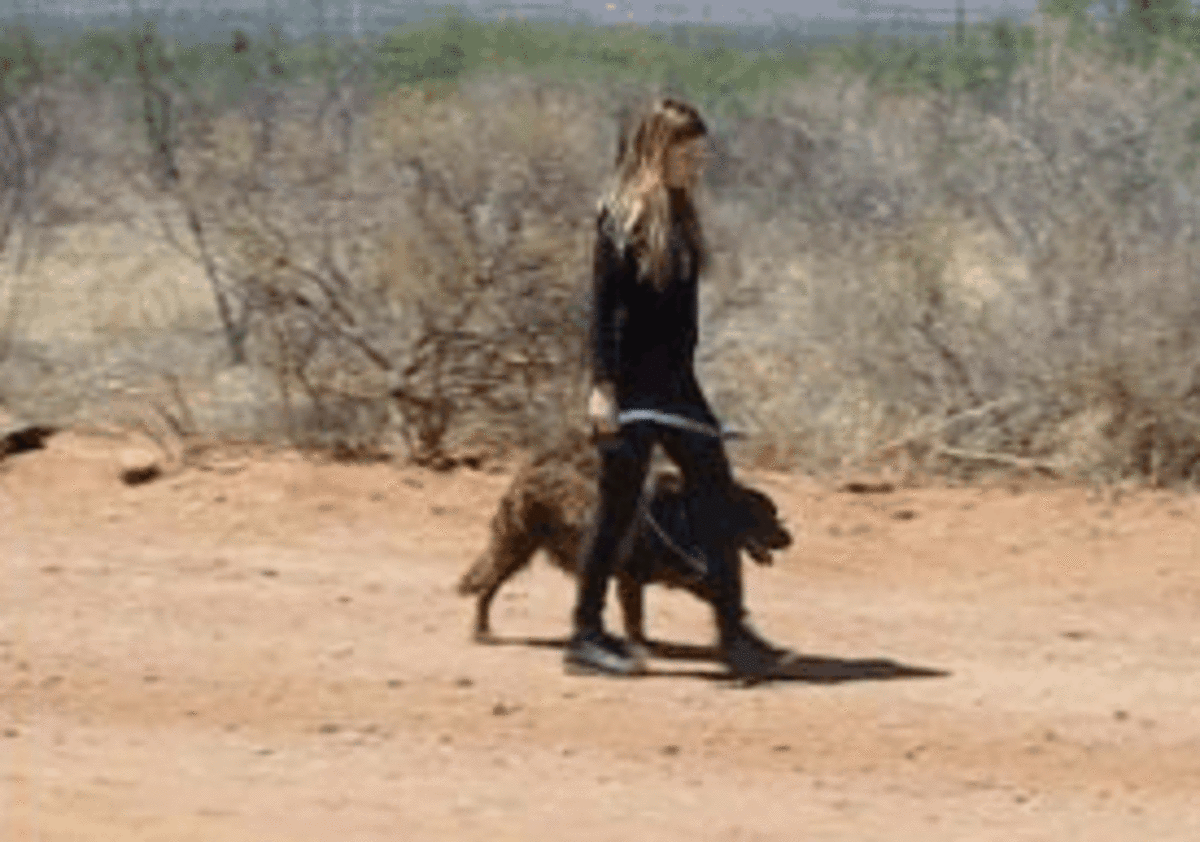Adrienne is a certified dog trainer, former veterinary assistant, and author
of the online dog training course “Brain Training for Dogs.”

Leash-Training Your Dog
Silvana Carlos
Dog Training: Who Is Walking Who?
As a certified dog trainer, I can attest that one of the most common problems
dog owners endure is being pulled around when taking their dog for a walk. The
problem is certainly not a small one. Leash-pulling can lead to several other
problems like:
- Being dangerously dragged.
- Being unable to control a potentially dangerous dog.
- Injuring others due to lack of control.
- Being unable to provide dogs with the leadership skills and guidance they crave.
Of course, an obedience trainer may be able to solve these problems, but not
all people have the financial resources to afford one or they simply may not
have the time. Some owners (and this is not that rare) may also refuse to go
to dog training school simply because they are too proud to seek out the help
of a professional. They would prefer to take care of the issue themselves,
even though they are not completely sure how.
Training Classes Offer Huge Advantages
Nothing can really replace the structured setting and opportunity for
socialization a class offers. Dogs learn to be under control despite high
distractions such as other dogs and people. If your dog is capable of walking
nicely on leash in this environment, it’s very likely he will be well under
control during your evening walk around the block! So taking your dog to dog
training is a big plus with many advantages.
The Secret to Getting Your Dog to Walk Nicely on a Leash
Your main objective is to have a dog that walks on a loose leash. Remember
this goal: A leash is just there because the law requires it; your dog will
follow because he just wants to be with you and knows that your side is the
best place on earth! Of course, this may seem like an unattainable goal, but
you will eventually get there.
So how to get a dog in this sort of mindset? It takes a mix of classical
conditioning, operant conditioning, and special tools for the most serious
cases. Let’s take a look at all of these components, one by one.
Classical Conditioning
Do you remember Pavlov and the studies on drooling dogs? If not, Pavlov was a
Russian scientist that started ringing a bell and offering food to dogs right
afterward. With time, it was noticed that dogs started salivating in
anticipation at the simple sight and sound of the bell! This helped us
understand how a dog thinks and take it to our advantage.
How do we apply this in dog training? It is quite simple. We make a sound and
classically condition the dog to associate it with something great such as
food. The sound can be anything, a whistle, a smack of the mouth, anything,
just do not use the dog’s name!
Rewarding With a Treat
Once we get the dog’s attention, we will bring the treat to our eye level and
then hand it to the dog. We will repeat the sound and then treat, sound,
treat, sound, treat… After some time, the dog will associate the sound with
food and will look forward to it. This is classical conditioning at best!
Once things start clicking in the dog’s mind, we are ready to start moving in
a fenced area. We walk with the dog and make the sound with the treat at eye
level and once the dog looks up making eye contact, we give the treat. With
practice, the dog will be attentive and heeling like a pro!
As the dog gets better, the dog is introduced to areas with more distractions.
This is where going to an obedience school is best: the dog will learn to not
pay attention to other dogs and people, rather he will choose to make you the
most interesting thing out there!
Operant Conditioning
Operant conditioning takes place when a dog starts thinking, ”If I do this, I
get something for it.” It puts the dog’s mind in a working mode. If the dog
looks at you and makes eye contact, he will quickly learn that eye contact
gets him the reward. This will make your dog eager to work and ”operate” for
the reward.
Most training today is reward based. While the older aversive training methods
focused in having a dog obey to ”avoid pain or discomfort” today, the dog is
encouraged to ”operate” for rewards. This positive method teaches the dog
two things: ”If I work I get something” and ” My owner brings good things
and I trust him” rather than fearing him and associating him with aversive
techniques.
Troubleshooting Walking Problems
So you have your dog walking nicely next to you, but what should you do if
your dog looks up at you, takes the treat, and then lunges forward, pulling
you and going back to his antics? Here you must be more stubborn than your dog
and not give in.
Scroll to Continue
Read More From Pethelpful

Why Does My Cat Sit on My Stuff?

Tips for Home Care for Your Vomiting Cat When You Cannot Visit the Vet

The Top 10 Fastest Dog Breeds
Stop as soon as the dog pulls and either:
- Walk in the opposite direction.
- Stop and put your dog back to being next to you and start walking ”together.”
There is only one bad thing that you can do in this exercise: follow your dog
when he pulls. Indeed, when we deal with pulling dogs we really are most
likely not dealing with a dog that wants to be ”dominant” or stubborn,
rather we are most likely dealing with a dog that simply thinks like this:
”On walks it works this way…I go forward and my owner follows.” In other
words, the dog just thinks he must drag his owner around, because he was never
taught otherwise!
It is just something that has worked in the past once or twice. Now the dog
assumes that is just the way it is. Not to mention the fact that going forward
is very rewarding to dogs and walking much faster than humans, they take the
puller role very easily.Once we stop walking when the dog pulls,once, twice
and more, then the dog starts thinking ”Oh, so it does not really work the
way I thought” and adjusts accordingly.
I Recommend This Book

Your ultimate goal should be to walk on a loose leash.
alexadry all rights reserved
Tools to Stop Dogs From Pulling
If you have a very large dog and simply do not have the strength to control
him, you may be wondering if there are any training tools that would at least
allow you to not be dragged along the way. There are different training tools
that may work.
Prong Collar Not Recommended
The prong collar was once recommended for dogs that lunged and pulled, but it
may bring a too strong of a correction to sensitive dogs or dogs that are
fearful or lunging out of defensive aggression, the ”I attack first to
prevent being attacked.” Since most people are not fully aware of what
emotions go through the dog’s mind, I would not recommend this training
device.
Head Halter or Body Harness
Preferable training tools are a head halter and a front attachment harness.
Head halters mimic somewhat what a horse wears. It gives owners a higher level
of control since it embraces the whole head and dogs seem to respond to it
more than an average leash.
The other option is the front-attachment harness, a harness with a front ring
that allows more control and its pressure on the chest area teaches the dog
how to respond properly. In order to work well, the dog must learn that it
must stay by the owner’s side with the use of treats at first. Dogs appear to
respond well to this tool and many people are quite satisfied with the
results.
No Device Will Replace Adequate Training
Of course, training devices may help gain control but let’s remember they are
simply tools. Nothing can replace actual training, which requires time,
patience and being persistent. If you stop allowing your dog to pull you and
abide to a ”no pulling policy” it may take an hour the first day to just
walk a block, but in the long run, your dog will soon understand that when he
is ahead of you, you will not go anywhere and it gets quite boring. If you are
more stubborn than your dog, you will ultimately win!

Teach your dog to walk as if leashes were not there.
Adrienne Copyright
Further Reading
- The Dangers of Using Retractable Dog Leashes
adry At a first glance, a retractable dog leash looks like a great tool for
dog owners willing to give their dogs a glimpse of freedom while still being
able to have a certain amount of control. Indeed a…
This content is accurate and true to the best of the author’s knowledge and
is not meant to substitute for formal and individualized advice from a
qualified professional.
© 2010 Adrienne Farricelli
Comments
Adrienne Farricelli (author) on December 12, 2013:
Thank you. this is one of my older articles, I have much better ones now!
Ana Maria Orantes from Miami Florida on December 11, 2013:
I like your article about dog training. Thank you for the good advice.
Eiddwen from Wales on September 14, 2011:
A very useful hub on what can be a very common problem. Thank you for sharing
Take care
Eiddwen.
Adrienne Farricelli (author) on January 20, 2011:
Positive Mindz; you have an Australian Shepherd which is a highly intelligent
dog that as a working dog needs lots of stimulation. Fail to give it a job and
very likely you will end up with problems.. are you exercising him and giving
him enough mental stimulation? this can be the source of the problem…also
you need to up your leadership skills.. obedience training can be started
already and I am sure your dog will greatly benefit from it.. best wishes!
SUSIE DUZY from Delray Beach, Florida on January 09, 2011:
Thanks for the tips. I will use some of them to train my dog, who barks at
other dogs.
bayoulady from Northern Louisiana,USA on January 08, 2011:
My dog puls when she is excited.After she calms down, she’s okay. I will try
your tips.
Billy Graham from Sarasota, FL on January 08, 2011:
Hello! First and foremost, I found your Hub to be Very informative and
interesting! I do have a few questions in regards to training… We have a 10
month old Australian ShepHerd named HarLey that is full of energy!! Like
others have stated, we are finding that he is more calm after being able to
expend some of his built up energy running and playing outside. My issue is
that we currently live in a community in which we don’t have the luxury of
allowing him to spend a lot of time outside. Fortunately, we have Family
around the corner with lots of land where we take him 2-3 times a week for
“Play Time”!
Issues:
-
Jumps on people when they come in the house
-
Sometimes pees when he meets new people
-
Chews up the kids toys even though he has plenty
-
Nips at ankles or pulls when walking on leash
-
Tortures poor Pumpkin (5 yr old cat) by chasing her 🙂
-
Eats out the trash and off the table
-
Constantly barks @ other animals (especially @ Beach)
Other than the items listed above, he’s a great companion for my Family (3
boys/2 girls)! LoL
Is he too young for obedience school? HarLey is a very smart and lovable
puppy! Trying to make the best of our relationship…
PosiTive Mindz
Adrienne Farricelli (author) on December 29, 2010:
A nice game of fetch or a jog around the block prior to the walk may help
release that pent up energy and put him in the state of mind for a calmer
walk.. your problem is quite common.. most dogs are really eager to get out
and tend to pull during the first minutes of the walk but then may settle and
calm down on the way back…
I am a bit surprised when people say ”treats do not work’with my dog.. What
types of treats are you using? Most dogs cannot resist some sliced up liver or
chunks of left over steak or skinless roasted chicken..I have seen people
stating their dog is not food oriented and then that same dog was drooling
buckets of saliva upon being presented with chopped up dried tripe of freeze
dried liver…
Also try to hide some treats in the yard or around the home prior to walking:
sniffing and searching for them mentally requires lots of concentration that
may wear him down a bit … best wishes!
Helen Murphy Howell from Fife, Scotland on December 28, 2010:
Hi,
Thanks for this great hub. I have a Border Collie,Roy, who is a rescue dog. He
does tend to pull going out to his walk, but is brilliant on the way back when
he has expended all his energy. He is not a greedy dog, and treats don’t work
with him. But you have given a lot of good information that I haven’t tried as
well as the books you have recommended. Many thanks again for a great hub.
Don A. Hoglund from Wisconsin Rapids on December 27, 2010:
I also have a rescued dog. She appears to have had some training but it is
hard to figure out exactly what. sometimes she walks by my side and other
times will pull.Haven’t figured out what triggers her behavior. She is also
shy of people.
Susan Zutautas from Ontario, Canada on December 27, 2010:
Found your hub very informative. I was recommended to use the prong collar on
my 2 Newfoundland dogs. I had tried every other method out there and the prong
collar was the answer to my situation. I walk both dogs at the same time and
the prong works really well for me. They are now trained to walk and no longer
pull. I only use this collar for walking and it comes off as soon as we hit
the house.
bruzzbuzz from Texas , USA on December 27, 2010:
Thank you for a useful and well written hub. I have a rescue dog who walks
good on a leash but needs training in other areas. I will definitely use these
methods.